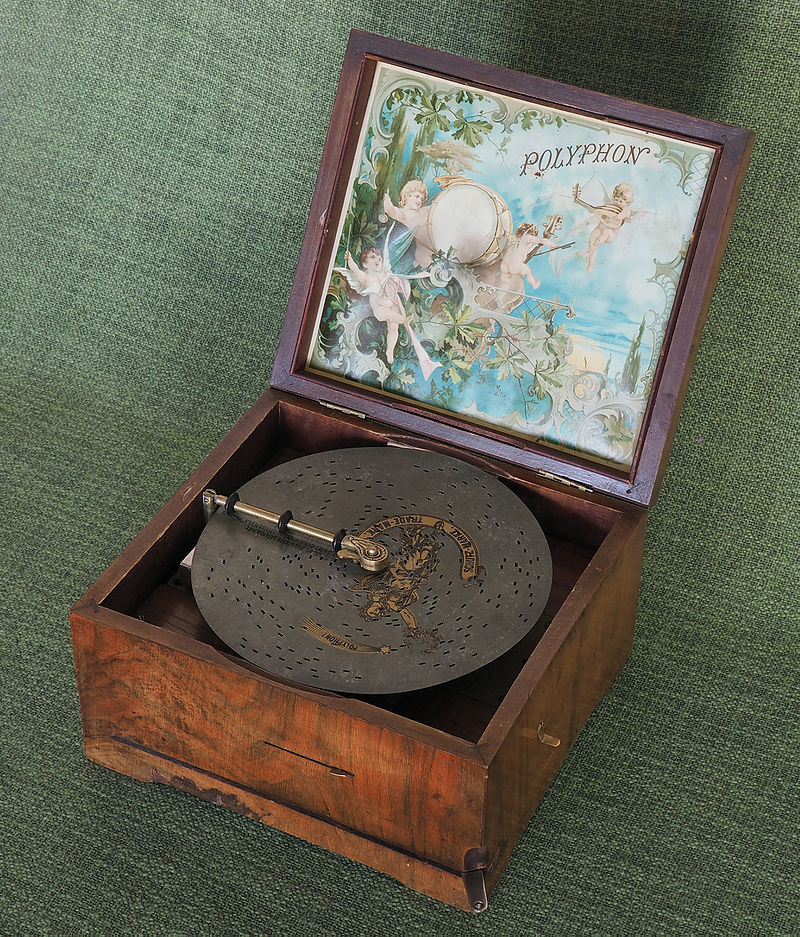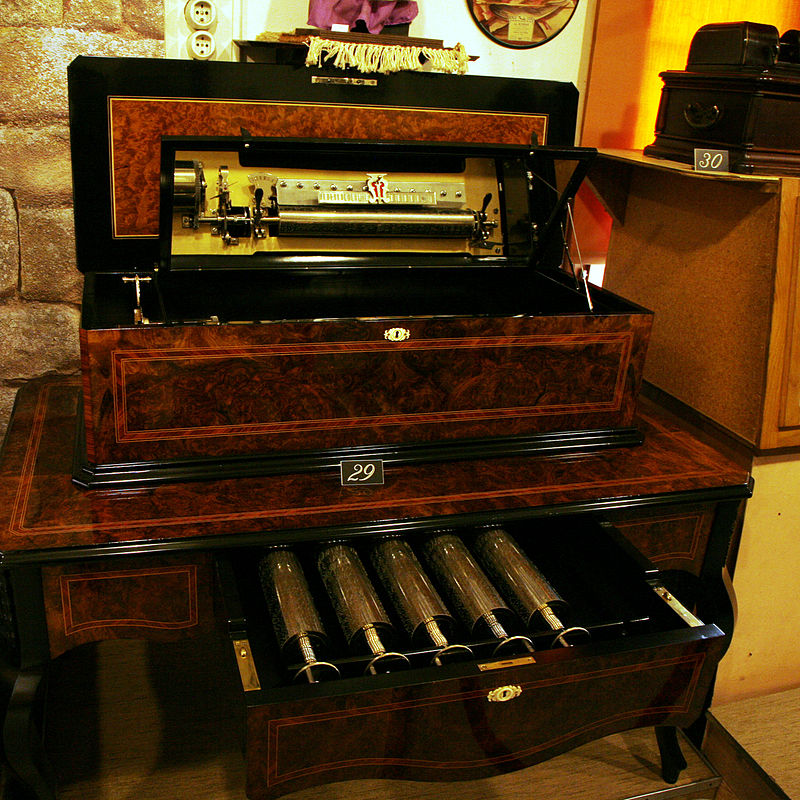Currently I'm "Over the sea to Skye", but have a WiFi connection today....so.....back to Percussion.
A
Music Box or
Musical Box is an automatic musical instrument, in a box that produces musical notes by using a set of pins placed on a revolving cylinder or disc to pluck the tuned teeth (or lamellae) of a steel comb.
They were developed from musical snuff boxes of the 18th century and called
Carillons ŕ musique (French for "chimes of music").
Some of the more complex boxes also contain a tiny drum and/or bells in addition to the metal comb.

Simple
Music BoxThe original snuff boxes were tiny containers which could fit into a gentleman's waistcoat pocket. The music boxes could have any size from that of a hat box to a large piece of furniture, but most were tabletop specimens. They were usually powered by clockwork and originally produced by artisan watchmakers.
These were the portable cassette or CD players of the period, and the privilege of playing a music piece to others, or for your personal benefit made them very desirable and therefore, popular.
For most of the 19th century, the bulk of music box production was concentrated in Switzerland, building upon a strong watchmaking tradition. The first music box factory was opened there in 1815 by Jérémie Recordon and Samuel Junod. There were also a few manufacturers in Bohemia and Germany. By the end of the 19th century, some of the European makers had opened factories in the United States.
The cylinders were normally made of metal and powered by a spring. In some of the costlier models, the cylinders could be removed to change melodies, thanks to an invention by Paillard in 1862, which was perfected by Metert of Geneva in 1879.
In some exceptional models, there were four springs, to provide continuous play for up to three hours.
The very first boxes at the end of the 18th century made use of metal disks. The switch over to cylinders seems to have been completed after the Napoleonic wars. In the last decades of the 19th century, however, mass-produced models such as the
Polyphon and others all made use of interchangeable metal disks instead of cylinders. Therefore, the cylinder-based machines rapidly became a minority.
Here is an example of a fine piece of furniture, with a music box in it, standing on a matching piece that housed the interchangeable cylinders.
 Music Box with interchangeable drums
Music Box with interchangeable drumsThe term "music box" is also applied to clockwork devices where a removable metal disk or cylinder was used only in a "programming" function without producing the sounds directly by means of pins and a comb. Instead, the cylinder (or disk) worked by actuating bellows and levers which fed and opened pneumatic valves which activated a modified wind instrument or plucked the chords on a modified string instrument. Some devices could do both at the same time and were often combinations of player pianos and music boxes, such as the
Orchestrion.
There were many variations of large music machines, usually built for the affluent of the pre-phonograph 19th century. Some were called the
Symphonium, others were called the
Concert Regina Music Boxmachine. Both variations were as tall as a grandfather clock and both used interchangeable large disks to play different sets of tunes. Both were spring-wound and spring driven and both had a bell-like sound. The machines were often made in England, Italy, and the US, with additional disks made in Switzerland, Austria, and Prussia. Early
juke-box pay versions of them existed in public places.
Many Museums still have still-working versions of them on public display.
At the end of the 19th century and the beginning of the 20th, most music boxes were gradually replaced by player pianos, which were louder and more versatile and melodious, when kept tuned, and by the smaller gramophones which had the advantage of playing back voices.
Escalating labour costs increased the price and further reduced volume. Now modern automation is helping bring music box prices back down and they are produced either for novelty or for the luxury market.
Collectors prize surviving music boxes from the 19th century and the early 20th century as well as new music boxes being made today in several countries. The cheap, small windup music box movements (including the cylinder and comb and the spring) to add a bit of music to mass-produced jewellery boxes and novelty items are now produced in countries with low labour costs.
Many kinds of music box movements are available to the home craft person, locally or through online retailers.
They may be very small and look insignificant, but when placed on a sounding board they can produce quite a high volume of sound.
In the next Reply, there is a helpful YouTube video where Music Boxes are explained.
Peter